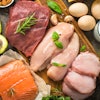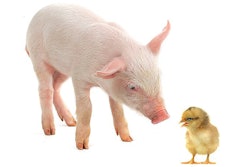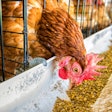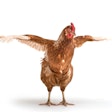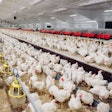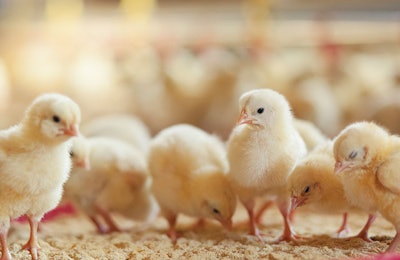
Efficiency is key to success in broiler production, and the importance of a good start in life is discussed for all species. In the case of broilers, the first three to five days actually represents a very significant proportion of a broiler's life — about 10 percent. The principle is therefore that what it eats during this time can impact its future performance.
The primary aim of a super pre-starter ration is to fulfill the specific nutritional needs of the young chick, supporting its transition from being fed by the yolk sac to the first diet consumed. Availability of nutrients immediately after hatch is critical for growth and development.
Young chick nutrition
Good intestinal development is essential in young birds for optimal growth and is related to immune function. The digestive system of the bird at hatch has limited ability to digest and absorb nutrients. It is therefore vital to provide a diet that contains highly digestible and available nutrients. The metabolizable energy and amino acid digestibility of grains are lower in young birds, and indigestible nutrients can serve as substrate for undesirable gut microorganisms.
“Correct doses of phytase, protease and carbohydrase enzymes all play a role in optimizing digestion and the gut environment at this time,” said Adam Smith, DSM market development manager — feed enzymes EMEA. “This will help to overcome the fact that digestibility of ingredients is lower and that endogenous enzyme levels are still on the increase.”
What is a broiler super pre-starter?
A diet fed to broiler chicks for the first four days is often referred to as a super pre-starter. As for standard starter diets, highly digestible ingredients are selected, but high-quality, high-value raw materials are used, more than doubling their cost. Different sources of protein, fats and carbohydrates will be used – for example soy protein isolates. They will have specific vitamin, mineral and amino acid specifications. Functional ingredients are also often included to offer benefits such as antioxidant protection.
“It is important to provide the neonatal chick with optimal nutrients in the right ratio and the right feed form,” said Albert Dijkslag, ForFarmers innovation manager and poultry nutritionist. “Ingredients should be highly palatable as well as easily digestible. You need to stimulate the metabolism from the beginning and, as well as gut health, it is essential to focus on skeletal development.”
What are their aims?
Promoting gut development
The gastrointestinal tract grows four times faster than the rest of the body during the first two weeks of life. It is this organ that is driving body weight gain and as such requires up to 40 percent of the energy and protein that the young bird consumes. High protein content is also necessary in diets for young birds, apart from for growth; protein plays a role in maintaining body temperature. Probiotics may added to diets to seed the gut with beneficial bacteria or protect it from pathogens.
Supporting the immune system
Development of the immune system starts in the embryo and continues after hatching. In the first week of life, there is a rapid increase in the number of leucocytes, due to the growth of the lymphoid organs. The synthesis of immune cells is a metabolically expensive process and is highly dependent on the presence of nucleotides. These protein building blocks can be found in significant amounts in certain concentrated protein products.
Antioxidant protection
A specific vitamin and mineral pre-mix would be used in super-pre starters to meet the specific needs. Focusing on other potential negative influences, such as oxidative stress, can also optimize a bird’s potential. As such, diets may contain particular levels and highly available sources of vitamin E and selenium. For example, selenoproteins play an important role in protecting the body from damage by free radicals.
And how do they work?
The aim should be to kick start the digestive system of the young chick as soon as possible. Food particle size and feed presentation will play a significant role in this. The diets are often in the form of crumbs or mini pellets and should be highly palatable and dust free.
“Dextrose is included as a source of fast energy,” Dijkslag said. “We make use of egg powder as a highly digestible form of protein as well as adapting the amino acid profile of the diet.”
The ideal ratio of total sulphur amino acids to lysine ratio for young chicks has been the focus of investigations. By supplying pure amino acids, the chick doesn’t have digest protein before benefiting. Their source may also be important; for example, those forms of methionine that are passively absorbed may be particularly suited to the still maturing gut.
Commercial application
There is a lot of interest in increasing the robustness of chicks and, as such, producers are testing super pre-starters. Many nutritionists, while believing in the aims of broiler super pre-starters, are not seeing large-scale commercial use. “Investment also needs to be made in chick placement and management,” Garland said. “Seeing a benefit at seven days does not always carry through to slaughter.”
Logistically, the use of super pre-starters needs some consideration. Its specialized nature means a standard feed mill would not have the specialist raw materials or equipment or expertise necessary to produce such a diet. Therefore, they are bought as bagged product from nutrition companies and may even be imported. This means higher handling costs and coordination with more than one feed supplier.
Economic implications
Uniformity is an important aim for broiler producers. To achieve this, feed intake should be maximized at critical stages to support gastrointestinal development. Closing the growth gap will be most cost effective when the birds are still young chicks.
"I believe that all broiler producers would benefit from using a broiler super pre-starter,” Dijkslag said. “It has been demonstrated that feeding the ForFarmers prestart increases return per broiler by EUR4.5 cents.”
Current and future trends
Development of the gastrointestinal and immune systems is important in modern broiler production to support growth and performance. By feeding a diet that specifically meets the requirements of a chick in the first few days of life is the best way to ensure a good start. It is a significant investment with the aim of promoting efficiency throughout the cycle.
Integrators are probably best placed to benefit directly from any improvement in growth rates or feed conversion. However, the benefits may not be universal or appropriate for all production systems. Where producers are reducing antibiotic usage, additional early support may be of particular use, as well as when using new hatching methods that provide immediate access to feed. Others question whether the money could be better spent on improving starter diets as a whole.

